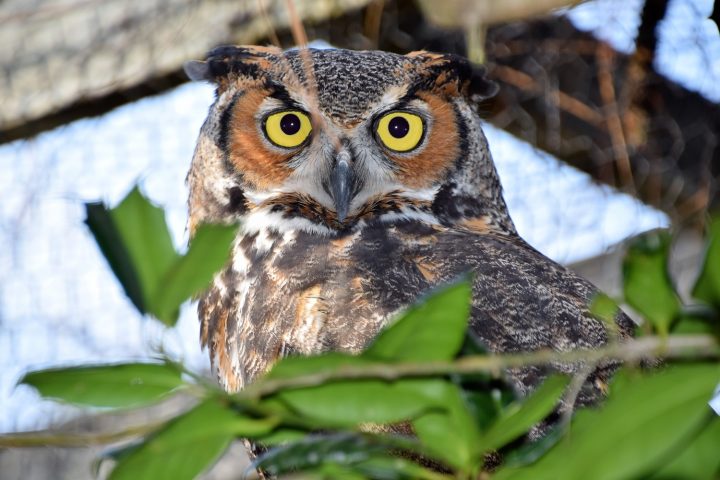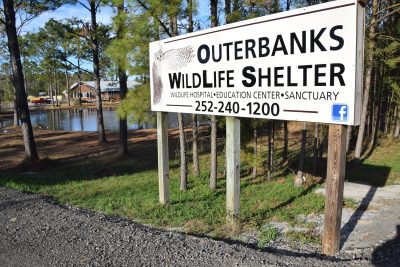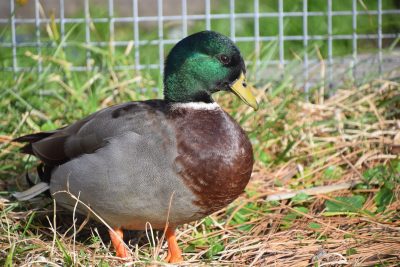
OCEAN — The official start of baby season for the Outer Banks Wildlife Shelter was Valentine’s Day.
“We start seeing baby owls, bunnies, opossums and squirrels around this time, baby ducks and geese at Easter and full-blown baby season is May to September,” said Brooke Breen, OWLS executive director.
Supporter Spotlight

That means OWLS, a wildlife rehabilitation center in Carteret County, needs lots of extra hands.
“Our hours go 8 a.m. to 8 p.m. every day, so if anyone wants to come in and help us feed all the little baby songbirds, we want them to apply,” she said. “The standard shift is four hours and can be the same shift or day or on a floating schedule. We teach everything on the fly. All we need from a prospective volunteer is be dependable, follow directions and a good sense of humor.”
In addition to raising wildlife babies, the nonprofit organization can help with any injured or sick wildlife and cares for many critters that can’t be released back into the wild after they’re healed, such opossums, screech owls, great-horned owls, red-tailed hawks, crows and a variety of waterfowl. OWLS will either send out a volunteer to rescue and collect the animal or the person who found the animal can bring it into the shelter.
Chris Kent, the District 2 coastal regional wildlife biologist for the North Carolina Wildlife Resources Commission, which covers the 12 southeastern counties from Pitt to New Hanover, emphasized that “If someone encounters an injured or sick animal, they really need to contact a biologist, wildlife enforcement officer or a wildlife rehabilitator before bringing that animal into their homes and potentially exposing their entire family.”
Kent said that many people don’t know that it’s against the law to possess wildlife in the state without a permit from Wildlife Resources Commission.
Supporter Spotlight
“Folks with good intentions are often not equipped with the correct knowledge and supplies to properly raise wildlife, nor do they have the necessary permits from my agency to do so,” he added.
“Often, especially in springtime, people find a baby animal and think it has been orphaned so they bring it home. Many times, this becomes a death sentence for that animal,” Kent said, explaining that often times the mothers have hidden their babies while they go search for food.
“When the mother returns and the baby is gone, the mother will eventually abandon the site and leave,” Kent said. “Even if my agency is able to retrieve that wildlife baby, often the animal is already too habituated to humans and cannot be released back into the wild, so it has to either be euthanized or rehomed.”
He added that any animal such as a raccoon, fox, skunk or coyote on the rabies vector species list “currently cannot legally be rehabilitated due to the public health implications of people potentially being exposed to rabies.”
Breen said that when encountering a sick or injured animal, “It is usually the best-case scenario if the finder can take action immediately. Seconds count.” She added that the more information that can be provided to the shelter about how the animal was found, the better.
Once the animal is in the shelter, it gets a head-to-toe physical, when all injuries and symptoms are cataloged. Then, appropriate medications and husbandry are assigned.
“The animal is in care until the problem is resolved. Then the patient will usually be placed in an outdoor enclosure for acclimation and observation. As long as the patient is self-feeding and able to get around, it is returned to the wild. Usually, we try to put the animal back in its home territory,” she said.
When an animal is too injured or sick, it is humanely euthanized just as it would be done in a veterinarian’s office.
If you need to handle the animal, Breen said to “Always make sure you don’t put your life in danger.”
Breen advised using a towel or blanket to help capture and restrain the animal.
“As soon as you cover its head and eyes, it should calm down, like a horse with blinders. A wild animal needs as little human sights and sounds as possible,” she said. “Any pointy parts are the ‘danger zone,’ i.e. talons or beak. Please transport immediately, with no radio or talking. Literally, a laundry basket, garbage can, cardboard box, pillowcase or paper bag will work for transport. Stress is the No. 1 killer of captive wildlife.”
Kent said that there are dozens of wildlife rehabilitators, like OWLS, in the state that are properly permitted by Wildlife Resources Commission.
“Usually these folks operate with no funding whatsoever. They use their own money and sometimes private donations in order to rehabilitate injured or legitimately orphaned wildlife and, hopefully, get those animals back into the wild where they need to be,” he said.
OWLS is one of the rehabilitation centers that receives no state or federal funding, so the shelter is always in need of monetary donations and anything off the supply wish list is welcome, Breen said.
“We only receive donations and grant money to run this place,” she said. “In general, our operational budget for the year is $150,000. The yearly admissions are at 2,000 animals. We are in need of regular shift volunteers and people to help us rebuild the enclosures, tend the grounds and rescue and transport.”
There are numerous ways that folks can contribute in lieu of money, as well.
Gently used clothing, furniture and household items can be taken to Second Go-Round Consignment shop in Newport or brought to OWLS.
OWLS also could use donations of food such as acorns, pecans, pyrocantha berries and fresh fish, all of which are integral to the successful rehabilitation and release of these animals, Breen explained.
OWLS, like many of the county’s nonprofits and businesses, is still recovering from Hurricane Florence, which struck the coast in September.
“We have been extremely blessed to have had community members pitching in to help us clean up and repair,” Breen said. “It’s a work in progress, but we have a new roof, the fence is being rebuilt, the enclosures still need attention and several enclosures yet need to be rebuilt. Baby season is looming, our busy time. We still need help.”
She added that the organization’s Facebook page is continually updated with what’s happening at the shelter and the OWLS website includes volunteer applications, wish lists, news and information.
“It’s a work in progress, but we have a new roof, the fence is being rebuilt, the enclosures still need attention and several enclosures yet need to be rebuilt. Baby season is looming, our busy time. We still need help.”
Brooke Breen, Director, Outer Banks Wildlife Shelter
Kent said that urban wildlife issues are becoming more common as development and habitat loss continue statewide.
“Many animals have adapted to thrive in close proximity to human neighborhoods and other population centers,” Kent continued. Humans often unwittingly encourage these interactions by feeding pets outdoors and with bird feeders, unsecured trash cans and compost piles.
“It is usually a food attractant that encourages wildlife to encroach on people’s property unwanted. If people are mindful of this and understand their actions around their property can invite unwanted guests, then slight modifications to our behavior can go a long way at preventing wildlife conflict.”
Kent said another factor on the coast are the folks who intentionally feed wildlife such as alligators, raccoons, squirrels and foxes or throw food scraps on the ground. “Human behavior like this teaches wildlife bad habits. It makes wildlife begin to lose their natural fear of humans and even associate humans with easy food.”
Education is one of the most important aspects of preventing wildlife conflicts.

“Many people love to see wildlife on their property and even plant specific vegetation, erect structures such as bat houses and bird baths, or grow edible plants in order to attract wildlife,” he said, and others don’t mind wildlife, just not in their yard.
Those who want to landscape their property with attractive or ornamental plants and shrubs but don’t want their investment to become food for deer and other wildlife should consult the commission’s deer-resistant plant guide on the website, which offers information on how to either attract specific types of wildlife or prevent wildlife conflicts.
“A simple way to prevent frustration and conflict with wildlife is to choose plants that wildlife are less interested in,” Kent said. “That doesn’t necessarily mean exotic vegetation from faraway lands. Many species of native vegetation have co-evolved with local wildlife and, therefore, have developed defense strategies to keep from being eaten. Or … it’s just not that palatable.”
What to Do to Be Wildlife Friendly
Brooke Breen of the Outer Banks Wildlife Shelter offers the following tips on what to be aware of and how to be more wildlife friendly:
- Don’t ever put out rodent poison. It takes days for them to die and they move slower so many animals that naturally eat mice snatch them up and are in turn poisoned too. One great horned owl eats about six mice per night … let them do their job.
- Pay attention to the weather reports. Don’t use insecticide, fertilizers or weed killer before a rainstorm. All that poison flows into the hunting waters and wildlife habitats.
- Choose an eco-friendly alternative to lead shot or sinkers. Lead shot is ingested passively by ducks and geese while they dabble under the water and is a slow, painful and nearly irreversible death sentence. Carrion feeders like vultures and eagles are frequently poisoned form eating deer and other widely hunted animals that are not removed after being shot. Fish-eating birds like pelicans, loons and gannets are found, upon necropsy to have lead sinkers and jigs stuck in their gastrointestinal tracts. It’s usually too late to save them from this poisoning, as the lead is impossible to pass and must be surgically removed, then chelation therapy to counteract the damage costs about $1,500 per animal.
- Keep your pets under supervision outside or don’t let them out at all so that they don’t become predators.
- Check the yard before mowing or burning. Cottontail rabbits love making nests in your yard. You may never see them active, but they are there. Box turtles are camouflaged and move slowly, making them another frequently injured animal.
- If you see or find an animal, call OWLS for a consultation before bringing it in. Many times, if the animal is not visibly sick or injured, you may be kidnapping them.
Learn More
- Visit the OWLS website
- Book a tour or program with OWLS by emailing owls.edu@yahoo.com











